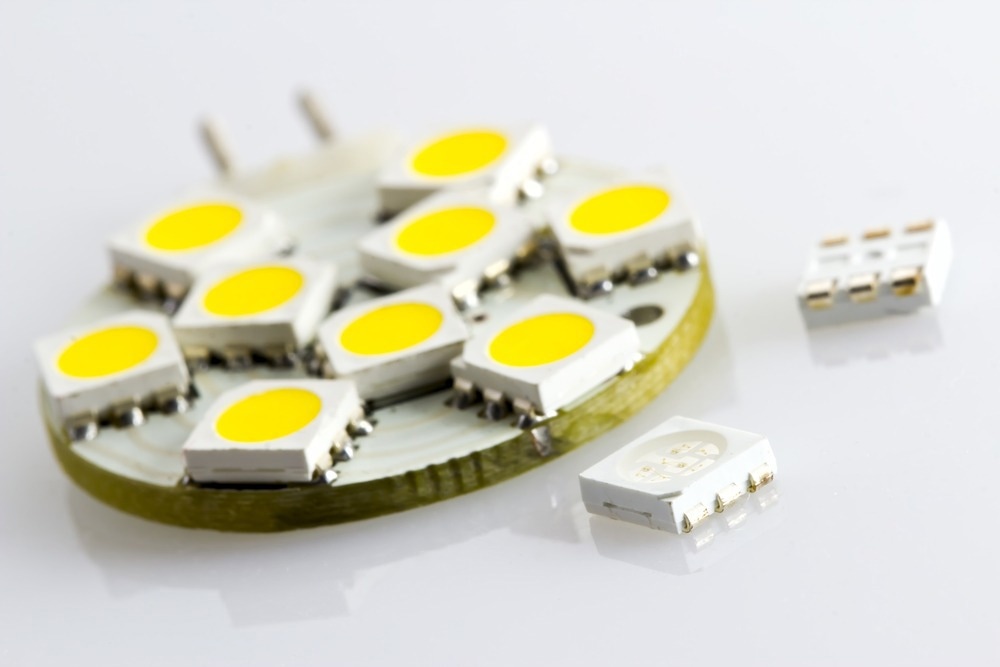Chronic blue-light exposure from the widespread use of white light emitting diode (WLED) lighting has harmful effects on circadian rhythm and human health. A prototype LED chip-pumped system employing blue phosphor reported by a recently published study in ACS Sustainable Chemistry & Engineering can create full-spectrum warm white light with diminished blue light intensity. The proposed blue phosphor has the potential to accelerate the manufacturing of human-centric WLED lighting.

Study: A Zero-Thermal-Quenching Blue Phosphor for Sustainable and Human-Centric WLED Lighting. Image Credit: ludinko/Shutterstock.com
Chronic Effects of Blue-Light on Human Health and Sleep-Wake Cycle
The circadian clock linked to sunlight regulates human physiological and behavioral cycles, including the sleep-wake cycle. Blue light, as opposed to other colors, has a greater propensity to interfere with circadian rhythm, depending on the regular day and night cycles.
The strong blue emission in the morning and midday bright white light can trigger photosensitive retinal ganglion cells, preventing the release of melatonin and keeping people awake. On the other hand, a faint blue tint might cause a surge in the sleep hormone melatonin and have a hypnotic effect in the evening’s softer, warmer white light.
Phosphor-converted white light emitting diodes (pc-WLEDs), which use a blue InGaN LED chip, is currently the most extensively used indoor lighting technology. Unfortunately, the widespread usage of a blue InGaN chip poses a major blue-light hazard, as the blue spike produced overlaps significantly with the wavelength-dependent melatonin suppression curve.
Midnight blue-light exposure can negatively impact human circadian rhythm and health, leading to weariness, sleeplessness, mood problems, retinal degeneration, and cataract development.
The majority of current research interests in the improvement of indoor lighting sources are currently concentrated on the improved energy efficiency and better color characteristics of pc-WLEDs, despite the prevalence of a blue-light hazard quickly developing into a global health concern.
Therefore, developing human-centric WLED lighting with weak blue emission is essential and urgent for safe and long-lasting lighting.
Blue Phosphor: A Solution to Industrialization of WLEDs
A violet LED chip is the best replacement for the InGaN blue LED chip since it can reduce the blue light produced by WLED devices. Combining a violet LED chip with highly effective red, blue, and green phosphors can achieve a full-spectrum emission with improved color tenability and selectivity.
Numerous commercial red and green phosphors have excellent temperature stability, exceptional chemical stability, and high quantum efficiency. They successfully eliminate the blue spike without sacrificing the color characteristics.
Using Zero-Thermal-Quenching Blue Phosphor to Diminish the Blue-Light Intensity
The Na3KMg7(PO4)6:Eu2+ blue phosphor was employed as the emitter in a chip-pumped prototype device with a violet LED chip. The blue phosphor exhibited zero thermal quenching, narrow-band emission, and superior color purity. It was produced through a solid-state reaction at a high temperature.
A Bruker D2 Phaser X-ray diffractometer helped obtain high-quality powder X-ray diffraction (XRD) data. The diffuse reflectance spectra were obtained using a Hitachi U-4100 UV-Vis spectrophotometer, with BaSO4 as the reference material.
The electron-phonon interaction was estimated by determining a material's Huang−Rhys factor.
A 715-ES inductively coupled plasma (ICP) spectrometer was used to determine the element content of the hydrolyzed liquid. The WLED gadget was created by combining a violet LED chip with commercial green, blue, and red phosphor.
The periodic system simulations utilized VASP software and density functional theory (DFT). An integrating sphere spectro-radiometer system helped examine the photoelectric characteristics of the WLED gadget.
Important Findings of the Study
The researchers utilized the solid-state reaction method to successfully produce a narrow-band blue phosphor with high color purity and a large band gap. The narrow-band emission of the blue phosphor is due to Eu2+ dopant accommodation in the Na(2) site.
Under identical measurement conditions, the NKMPO:Eu2+ phosphor exhibits higher wide-band absorption and emission intensities than commercial BAM:Eu2+. The internal/external quantum efficiency of the NKMPO:Eu2+ phosphor was 89.0/32.5% when excited at 400 nm.
The NKMPO:Eu2+ phosphor is very resistant to dampness. The zero-thermal quenching phenomenon occurs because 5d excited-state electron thermal ionization is prevented. A violet LED chip-pumped prototype device using the Na3KMg7(PO4)6:Eu2+ phosphor as an emitter can drastically reduce blue-light intensity.
The proposed blue phosphor enables the industrialization and future development of sustainable human-centric lighting.
Challenges
The main challenge with this strategy is the shortage of highly effective blue phosphor, which needs a slight stokes-shift to effectively diminish the intensity of blue light.
The commercial Na3KMg7(PO4)6:Eu2+ blue phosphor has a relatively moderate absorption in the violet region. Therefore, it is not easily activated by 400 nm light, despite its high quantum efficiency and exceptional thermal stability. Additionally, it is costlier because of the high production temperature of BAM:Eu2+.
Another requirement for phosphors in environmentally friendly and human-centered WLED lighting is chromaticity stability with rising temperature. Therefore, finding a very effective blue phosphor with a tiny stokes shift, high quantum efficiency, outstanding thermal stability, exceptional chemical stability, and chromaticity stability is the main challenge for producing sustainable and human-centric lighting.
Reference
Zhihua Leng, Hao Bai, Qing Qing, Hongbo He, Jiayi Hou, Bingying Li, Zuobin Tang, Fang Song, and Hongyue Wu. (2022). A Zero-Thermal-Quenching Blue Phosphor for Sustainable and Human-Centric WLED Lighting. ACS Sustainable Chemistry & Engineering. https://pubs.acs.org/doi/10.1021/acssuschemeng.2c03028
Disclaimer: The views expressed here are those of the author expressed in their private capacity and do not necessarily represent the views of AZoM.com Limited T/A AZoNetwork the owner and operator of this website. This disclaimer forms part of the Terms and conditions of use of this website.